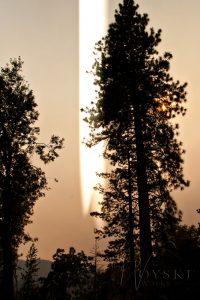How did the fire start?

The Detwiler Fire started in the afternoon on Sunday, July 16th. When it comes to smoke, my nickname is “The Nose”, but surprisingly, I was unaware of the fire until it was brought to my attention. Standing on our deck, we could see plumes of smoke, and although it looked like the smoke was coming from the ridge on the other side of our little valley, it was actually about 20 miles away, near Lake McClure. We felt confident that we would be unaffected by this fire. Little did we know that this would be a fire for the record books.
I took photos of the smoke from our deck. The white dagger in the photo is a broken shutter.
According to Cal Fire officials, the specific circumstances are still under investigation; however, they believe the fire was started by the discharge of firearms in the area of Hunter’s Valley.
Why was The Detwiler Fire so Devastating?
According to Nancy Koerperich, the Chief of the Madera-Mariposa-Merced Cal Fire Unit, there are many reasons why this fire was record-setting:
- There was a LOT of vegetation. The county had just had one of the wettest winters, so the grasses were abundant and tall and the underbrush was thick. This made the fire burn hot and fast.
- The weather was NOT helpful; normally the nights cool off and the humidity increases, helping the fire-fighting effort. But it was warm, windy and very dry (as I recall, the humidity was less than 20%) and for several nights, the Detwiler Fire doubled, and at one point, tripled in size overnight.
- The Detwiler Fire ran fast. The Harlow Fire from 1961 is considered to be one of the fastest running fires in history. Officials believe that at one point, the Detwiler Fire ran faster than the Harlow Fire. Additionally, the fire consumed 43,000 acres in one day.
- CAL FIRE calculated the rate at which the Detwiler Fire spread. It determined the percentage of embers that moved out ahead and sparked more fires was 100%. Under normal circumstances, a high rate of spread is calculated at 40%. According to Cal Fire, there were times when every ember from the Detwiler Fire was causing another fire.
- There were 14 other fires burning in the state at the time, limiting resources.
- Normally, firefighters look for a place where they can stop the blaze and focus their efforts there. The Detwiler Fire was spreading rapidly in all directions, so the firefighting focus was on protecting structures.
On two separate days, we drove around the county to view the damage done by the Detwiler Fire. There are areas where just the underbrush burned and it looks as though the trees will survive and by next spring, you might hardly know there was a fire. There were other areas where everything burned and there is nothing left but black sticks and white ash. The fire twisted and turned and burned here but not there. One thing surprised me; none of the areas we visited had a burned aroma. But there is ash everywhere and the slightest breeze picks it up and carries it away. In several locations we saw cinder cyclones (dust devils, but in the ash). It’s very hazy here and I think there is still some smoke in the air, but there is also ash in the air, picked up by the wind and the little cyclones that pop up spontaneously on the hillsides.
We spoke to a homeowner in Yaqui Gulch who said they watched on the news as firefighters attempted to protect their home. They were lucky and their home was saved but 7 of their 11 neighbors were not lucky. In total, the Detwiler Fire burned over 81,000 acres and 63 families lost their homes. It was not the worst fire in Mariposa County’s history, but the loss and devastation were extensive and heartbreaking to see.





















































